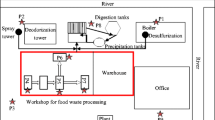Abstract
Odor from human waste/livestock manure treatment facilities has the potential to cause significant annoyance and to impact the amenity. In this study, odor emission characteristics at unit process of 38 human waste/livestock manure treatment facilities were evaluated using composite odor concentration and hydrogen sulfide (H2S) concentration. The values of composite odor concentration (geometry mean) and H2S concentration (median) for screening and storage basin were higher than those for the other treatment processes. The composite odor concentration and H2S concentration were distributed over a wide area in each process. Composite odor concentration (dilution ratio) was found to have the significant correlation with H2S concentration (p = 0.000 < 0.05). The H2S concentration accounted for 83.2% (human waste treatment facilities), 86.8% (livestock manure treatment facilities) of composite odor concentration.
Similar content being viewed by others
References
IIHE (2010). The report of Incheon metropolitan government research institute of public health and environment, Vol. 12, Incheon Institute of Health and Environment, Korea
KECO (2011). Casebook of odor technology diagnosis, Korea Environment Corporation, Korea
Kim, H. B., Jeong, S. J., and Song, I. S. (2007). “The concentrations of sulfur compounds and sensation of odor in the residential area around banwol-sihwa industrial complex.” Journal of Korean Society for Atmospheric Environment, Vol. 23, No. 2, pp. 147–157.
Lee, K. M. and Jo, Y. M. (2010). “Characterization of Odorous Elements from Livestock Wastes Treatment Plant.” Korean Journal of Odor Research and Engineering, pp. 49–54.
Ministry of Environment (2007). A guide of odor management, Korea.
Ministry of Environment (2012). Improvement of comprehensive policy of offensive odor control law, Law No. 11259, Korea.
NIER (2007). Standard methods of foul odor, National Institute of Environmental Research, Korea.
Ohh, S. J. (1999). “Status and creation theory of odor types in a swinery.” Korea Swine Journal, Vol. 21, No. 11, pp. 114–117.
Park, S.-J. (2003). “A study on odor concentration of malodorous gases emitted from sewage treatment plants using air dilution sensory test.” Korean Journal of Odor Research and Engineering, Vol. 2, No. 1, pp. 32–37.
Park, G. H., Oh, G. Y., Jung, K. H., Jung, S. Y., and Cha, G. S. (2005). “The odor characteristics of livestock raising facility.” Korean Journal of Odor Research and Engineering, Vol. 4, No. 4, pp. 207–215.
Yu, M. S., Yang, S. B., and Lee, O. K. (2002). “Simple prediction of odor affection by odor emission rate from a chemical plant.” J. of the Environmental Science, Vol. 11, No. 4, pp. 383–389.
Author information
Authors and Affiliations
Corresponding author
Rights and permissions
About this article
Cite this article
Yoon, HS., Seong, KW. & Choi, KS. A study of odor emission characteristics from human waste/livestock manure treatment facilities in Korea. KSCE J Civ Eng 19, 564–571 (2015). https://doi.org/10.1007/s12205-013-0618-0
Received:
Accepted:
Published:
Issue Date:
DOI: https://doi.org/10.1007/s12205-013-0618-0




